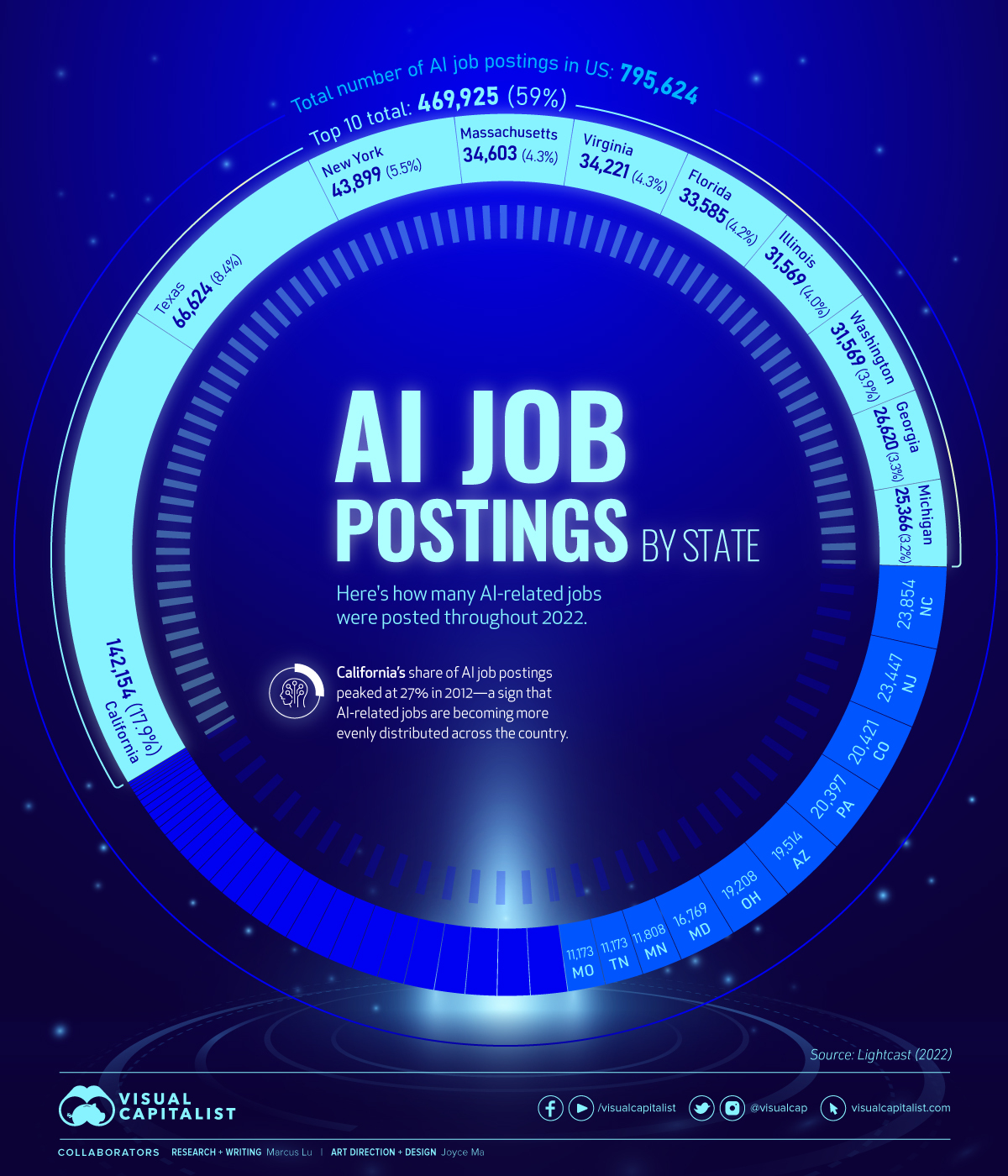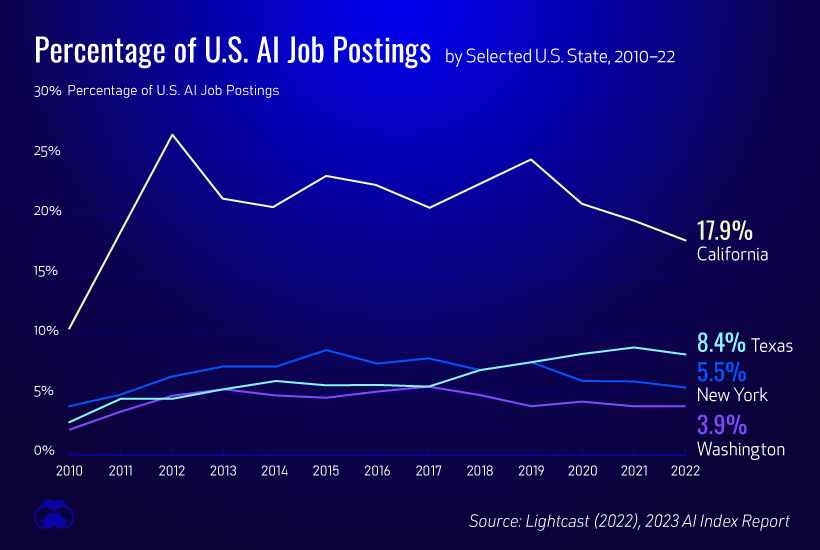Technology
Visualizing the Top U.S. States for AI Jobs

Visualizing the Top U.S. States for AI Jobs
Much ink has been spilled over fears that artificial intelligence (AI) will eliminate jobs in the economy. While some of those fears may be well-founded, red-hot interest in AI innovation is creating new jobs as well.
This graphic visualizes data from Lightcast, a labor market analytics firm, which shows how many AI-related jobs were posted in each state throughout 2022.
In total there were 795,624 AI jobs posted throughout the year, of which 469,925 (59%) were in the top 10. The full tally is included in the table below.
| Rank | State | Number of job postings | % of total |
|---|---|---|---|
| 1 | California | 142,154 | 17.9% |
| 2 | Texas | 66,624 | 8.4% |
| 3 | New York | 43,899 | 5.5% |
| 4 | Massachusetts | 34,603 | 4.3% |
| 5 | Virginia | 34,221 | 4.3% |
| 6 | Florida | 33,585 | 4.2% |
| 7 | Illinois | 31,569 | 4.0% |
| 8 | Washington | 31,284 | 3.9% |
| 9 | Georgia | 26,620 | 3.3% |
| 10 | Michigan | 25,366 | 3.2% |
| 11 | North Carolina | 23,854 | 3.0% |
| 12 | New Jersey | 23,447 | 2.9% |
| 13 | Colorado | 20,421 | 2.6% |
| 14 | Pennsylvania | 20,397 | 2.6% |
| 15 | Arizona | 19,514 | 2.5% |
| 16 | Ohio | 19,208 | 2.4% |
| 17 | Maryland | 16,769 | 2.1% |
| 18 | Minnesota | 11,808 | 1.5% |
| 19 | Tennessee | 11,173 | 1.4% |
| 20 | Missouri | 10,990 | 1.4% |
| 21 | Oregon | 10,811 | 1.4% |
| 22 | Washington, D.C. | 9,606 | 1.2% |
| 23 | Indiana | 9,247 | 1.2% |
| 24 | Connecticut | 8,960 | 1.1% |
| 25 | Wisconsin | 8,879 | 1.1% |
| 26 | Alabama | 7,866 | 1.0% |
| 27 | Kansas | 7,683 | 1.0% |
| 28 | Arkansas | 7,247 | 0.9% |
| 29 | Utah | 6,885 | 0.9% |
| 30 | Nevada | 6,813 | 0.9% |
| 31 | Idaho | 6,109 | 0.8% |
| 32 | Oklahoma | 5,719 | 0.7% |
| 33 | Iowa | 5,670 | 0.7% |
| 34 | South Carolina | 4,928 | 0.6% |
| 35 | Louisiana | 4,806 | 0.6% |
| 36 | Kentucky | 4,536 | 0.6% |
| 37 | Nebraska | 4,032 | 0.5% |
| 38 | Delaware | 3,503 | 0.4% |
| 39 | New Mexico | 3,357 | 0.4% |
| 40 | Rhode Island | 2,965 | 0.4% |
| 41 | New Hampshire | 2,719 | 0.3% |
| 42 | Hawaii | 2,550 | 0.3% |
| 43 | Mississippi | 2,548 | 0.3% |
| 44 | Maine | 2,227 | 0.3% |
| 45 | South Dakota | 2,195 | 0.3% |
| 46 | Vermont | 1,571 | 0.2% |
| 47 | North Dakota | 1,227 | 0.2% |
| 48 | Alaska | 970 | 0.1% |
| 49 | West Virginia | 887 | 0.1% |
| 50 | Montana | 833 | 0.1% |
| 51 | Wyoming | 769 | 0.1% |
The following chart adds some context to these numbers. It shows how the percentage of AI job postings in some of the top states has changed since 2010.

We can see that California quickly became the primary destination for AI jobs in the early 2010s, presumably as Silicon Valley companies began developing the technology.
California’s share has since declined, with a significant number of jobs seemingly moving to Texas. In fact, many tech companies are relocating to Texas to avoid California’s relatively higher taxes and cost of living.
The 10 Most In-Demand Specialized Skills
Lightcast also captured the top 10 specialized skills that were required for AI-related jobs. These are listed in the table below.
| Skill | Frequency (number of postings) | Frequency (% of postings) |
|---|---|---|
| Python | 296,662 | 37% |
| Computer Science | 260,333 | 33% |
| SQL | 185,807 | 23% |
| Data Analysis | 159,801 | 20% |
| Data Science | 157,855 | 20% |
| Amazon Web Services | 155,615 | 19% |
| Agile Methodology | 152,965 | 19% |
| Automation | 138,791 | 17% |
| Java | 133,856 | 17% |
| Software Engineering | 133,286 | 17% |
If you’re interested in a career that focuses on AI, becoming proficient in Python is likely to be a good first step.
Technology
Charting the Next Generation of Internet
In this graphic, Visual Capitalist has partnered with MSCI to explore the potential of satellite internet as the next generation of internet innovation.

Could Tomorrow’s Internet be Streamed from Space?
In 2023, 2.6 billion people could not access the internet. Today, companies worldwide are looking to innovative technology to ensure more people are online at the speed of today’s technology.
Could satellite internet provide the solution?
In collaboration with MSCI, we embarked on a journey to explore whether tomorrow’s internet could be streamed from space.
Satellite Internet’s Potential Customer Base
Millions of people live in rural communities or mobile homes, and many spend much of their lives at sea or have no fixed abode. So, they cannot access the internet simply because the technology is unavailable.
Satellite internet gives these communities access to the internet without requiring a fixed location. Consequently, the volume of people who could get online using satellite internet is significant:
| Area | Potential Subscribers |
|---|---|
| Households Without Internet Access | 600,000,000 |
| RVs | 11,000,000 |
| Recreational Boats | 8,500,000 |
| Ships | 100,000 |
| Commercial Aircraft | 25,000 |
Advances in Satellite Technology
Satellite internet is not a new concept. However, it has only recently been that roadblocks around cost and long turnaround times have been overcome.
NASA’s space shuttle, until it was retired in 2011, was the only reusable means of transporting crew and cargo into orbit. It cost over $1.5 billion and took an average of 252 days to launch and refurbish.
In stark contrast, SpaceX’s Falcon 9 can now launch objects into orbit and maintain them at a fraction of the time and cost, less than 1% of the space shuttle’s cost.
| Average Rocket Turnaround Time | Average Launch/Refurbishment Cost | |
|---|---|---|
| Falcon 9* | 21 days | < $1,000,000 |
| Space Shuttle | 252 days | $1,500,000,000 (approximately) |
Satellites are now deployed 300 miles in low Earth orbit (LEO) rather than 22,000 miles above Earth in Geostationary Orbit (GEO), previously the typical satellite deployment altitude.
What this means for the consumer is that satellite internet streamed from LEO has a latency of 40 ms, which is an optimal internet connection. Especially when compared to the 700 ms stream latency experienced with satellite internet streamed from GEO.
What Would it Take to Build a Satellite Internet?
SpaceX, the private company that operates Starlink, currently has 4,500 satellites. However, the company believes it will require 10 times this number to provide comprehensive satellite internet coverage.
Charting the number of active satellites reveals that, despite the increasing number of active satellites, many more must be launched to create a comprehensive satellite internet.
| Year | Number of Active Satellites |
|---|---|
| 2022 | 6,905 |
| 2021 | 4,800 |
| 2020 | 3,256 |
| 2019 | 2,272 |
| 2018 | 2,027 |
| 2017 | 1,778 |
| 2016 | 1,462 |
| 2015 | 1,364 |
| 2014 | 1,262 |
| 2013 | 1,187 |
Next-Generation Internet Innovation
Innovation is at the heart of the internet’s next generation, and the MSCI Next Generation Innovation Index exposes investors to companies that can take advantage of potentially disruptive technologies like satellite internet.
You can gain exposure to companies advancing access to the internet with four indexes:
- MSCI ACWI IMI Next Generation Internet Innovation Index
- MSCI World IMI Next Generation Internet Innovation 30 Index
- MSCI China All Shares IMI Next Generation Internet Innovation Index
- MSCI China A Onshore IMI Next Generation Internet Innovation Index
MSCI thematic indexes are objective, rules-based, and regularly updated to focus on specific emerging trends that could evolve.

Click here to explore the MSCI thematic indexes

-

 Technology2 weeks ago
Technology2 weeks agoCountries With the Highest Rates of Crypto Ownership
While the U.S. is a major market for cryptocurrencies, two countries surpass it in terms of their rates of crypto ownership.
-

 Technology2 weeks ago
Technology2 weeks agoMapped: The Number of AI Startups By Country
Over the past decade, thousands of AI startups have been funded worldwide. See which countries are leading the charge in this map graphic.
-

 Technology3 weeks ago
Technology3 weeks agoAll of the Grants Given by the U.S. CHIPS Act
Intel, TSMC, and more have received billions in subsidies from the U.S. CHIPS Act in 2024.
-

 Technology4 weeks ago
Technology4 weeks agoVisualizing AI Patents by Country
See which countries have been granted the most AI patents each year, from 2012 to 2022.
-

 Technology4 weeks ago
Technology4 weeks agoHow Tech Logos Have Evolved Over Time
From complete overhauls to more subtle tweaks, these tech logos have had quite a journey. Featuring: Google, Apple, and more.
-

 AI1 month ago
AI1 month agoRanked: Semiconductor Companies by Industry Revenue Share
Nvidia is coming for Intel’s crown. Samsung is losing ground. AI is transforming the space. We break down revenue for semiconductor companies.
-

 United States1 week ago
United States1 week agoMapped: Countries Where Recreational Cannabis is Legal
-

 Healthcare2 weeks ago
Healthcare2 weeks agoLife Expectancy by Region (1950-2050F)
-

 Stocks2 weeks ago
Stocks2 weeks agoThe Growth of a $1,000 Equity Investment, by Stock Market
-

 Markets2 weeks ago
Markets2 weeks agoMapped: Europe’s GDP Per Capita, by Country
-

 Money2 weeks ago
Money2 weeks agoCharted: What Frustrates Americans About the Tax System
-

 Technology2 weeks ago
Technology2 weeks agoCountries With the Highest Rates of Crypto Ownership
-

 Mining2 weeks ago
Mining2 weeks agoWhere the World’s Aluminum is Smelted, by Country
-

 Personal Finance2 weeks ago
Personal Finance2 weeks agoVisualizing the Tax Burden of Every U.S. State









